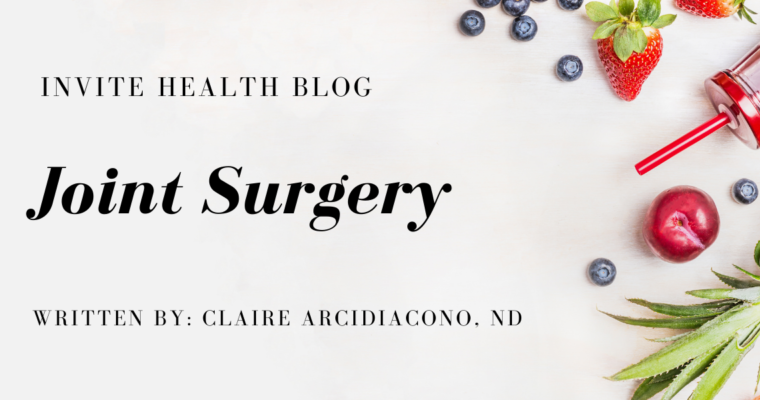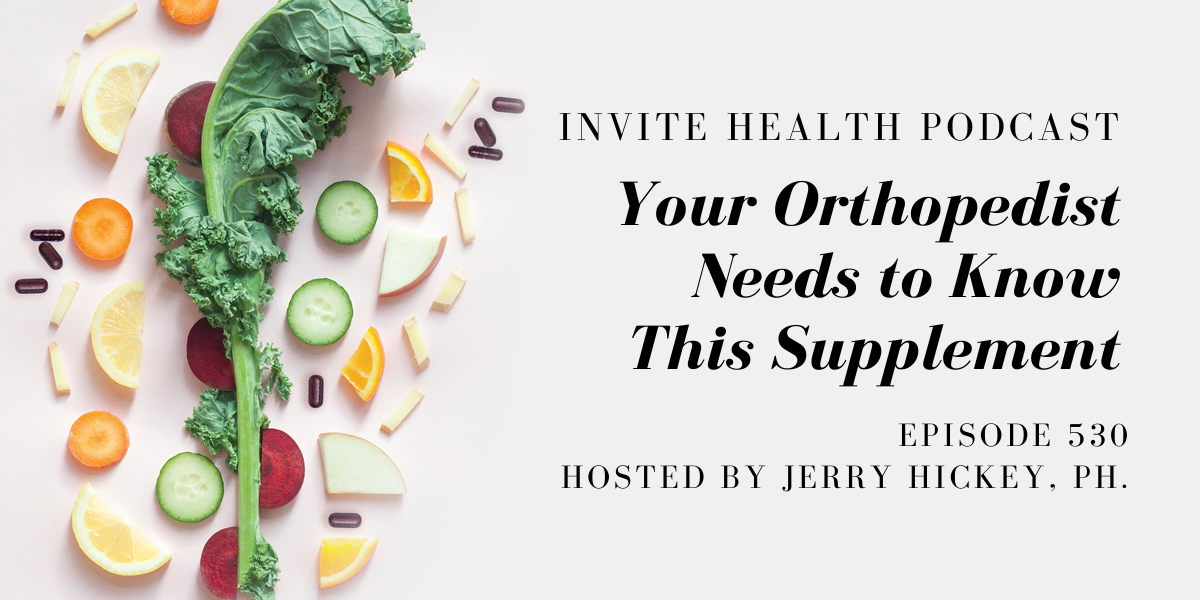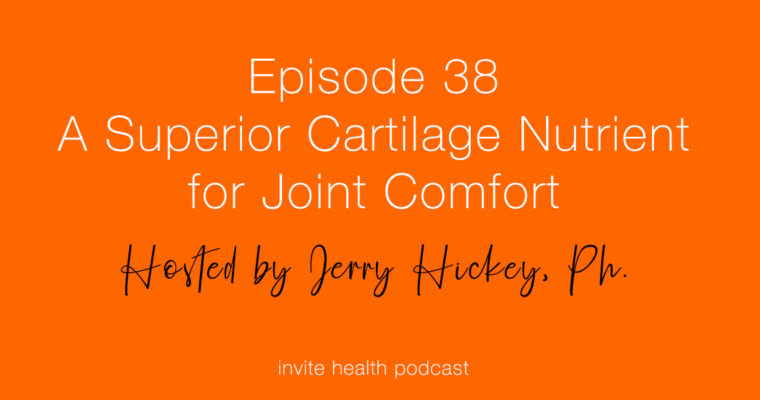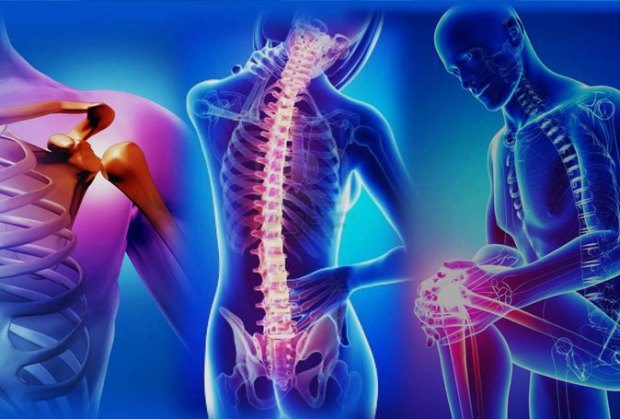orthopedist orthopedist
Subscribe Today!
Please see below for a complete transcript of this episode.
Your Orthopedist Needs to Know This Supplement – InViteⓇ Health Podcast, Episode 530
Hosted by Jerry Hickey, Ph.
*Intro music*
InViteⓇ Health Podcast Intro: Welcome to the InViteⓇ Health Podcast, where our degreed healthcare professionals are excited to offer you the most important health and wellness information you need to make informed choices about your health. You can learn more about the products discussed in each of these episodes and all that InViteⓇ Health has to offer at www.invitehealth.com/podcast. First time customers can use promo code PODCAST at checkout for an additional 15% off your first purchase. Let’s get started!
[00:00:40] Arthritis is terrible, it can ruin your day. There’s pain, stiffness, sometimes tenderness. It really limits your ability to participate in things, to perform physical activity and exercise. It can affect your mobility. Now, the most common form of arthritis is osteoarthritis, and it can range from very mild to very severe. And the worse it is, the worse the pain, which prevents or greatly limits your physical activity and your mobility. It affects about 25% of all adults over the age of 60. It becomes much more common after the age of 40. It’s more common in women than men. It’s more common in diabetics. And this is data from the Journal of Clinical and Geriatric Medicine.† [00:01:31]
[00:01:33] Doctors typically treat mild osteoarthritis with NSAIDs, drugs like Advil and Aleve, and physical therapy to strengthen the muscles around the leg for greater support. The NSAIDs, of course, have a lot of side effects. Strongly recommend physical therapy. Now there’s a safe and convenient supplement that works as well as the NSAIDs like Celebrex, Advil and Aleve, but it has the added advantage of being very easy to administrate. You only have to take one tiny, easy to swallow capsule every morning. You could take it with or without food. It’s American sourced. It’s extremely safe. And it has GRAS certification, generally recognized as safe for you to use. An orthopedic doctor should really become conversant with the supplement. It’s called UC-IIⓇ. So welcome to my episode, Orthopedic Doctors Need to Know This Supplement. My name is Jerry Hickey. I’m a licensed pharmacist specializing in nutrition, which I’ve studied for many decades. Now, as far as it goes, you can find all of our InViteⓇ episodes, all of our podcasts for free wherever you listen to episodes, or just go to invitehealth.com/podcast. You can also find us on Instagram, Twitter and Facebook @invitehealth. Please subscribe and leave us a review.† [00:03:06]
[00:03:07] So let’s get going. First, what is your joint? Well, and what is cartilage? Your joints are where your bones meet, so you can’t open a door without a hinge to swing the door and keep it upright. It’s the same with a joint. The joint acts like the hinge between your bones now, so you can move so you have mobility. They’re also designed to really protect the ends of your bones. So obviously, if there’s a lot of damage to the joint, this can affect the end of your bones also. Now, the knee joint is the most common point where you suffer with arthritis, with osteoarthritis, the most common by far form of arthritis. It connects the thigh bone, which is called your femur, with the shin bone, which is called your tibia. So what are, what else is involved? There’s ligaments that connect the bones to each other, and there’s tendons that connect your muscles to your bones so you can move them. So cartilage covers the end of your bone. It cushions them. It’s tough. It’s a slippery substance. In osteoarthritis, your cartilage is increasingly damaged or degraded. This takes time. It happens gradually, typically. The type of cartilage in your joints is called hyaline cartilage. There’s other forms of cartilage. It’s also found in your nasal septum and your respiratory tract. So cartilage is tough, yet it’s flexible. It’s made out of water and a matrix. So the matrix is the superstructure of the cartilage. The matrix is the superstructure. It’s made out of proteins. It’s made out of collagen and it’s made out of proteoglycans. The hyaline cartilage in your knee is roughly 70% water, but the amount of water and the amount of fluid in it declines with age. So that’s one of the problems. That’s one of the reasons why you’re more prone to osteoarthritis with age.† [00:05:16]
MSM FOR MORE THAN JOINT HEALTH – INVITE HEALTH PODCAST, EPISODE 521. Listen Now>>
[00:05:17] Proteoglycans are very interesting. They fill up the spaces in between the cells and your joint cartilage. So proteoglycans are mostly made up of glycosaminoglycans, so think chondroitin and glucosamine. Everybody’s heard of glucosamine and chondroitin by now, it’s the most popular joint supplement. It does work. The only cells found in cartilage are called chondrocytes. They make and they maintain and they repair the cartilage. So the hyaline cartilage in your joint, like in your knee joint, is very smooth and it’s slippery, and it allows your bones to glide over one another when you move. So the cartilage, besides being called hyaline in the joints, just to let you know, so you don’t get confused, it’s also called articular cartilage. It’s the cushion in a joint. It’s the shock absorber. It’s the coating on the outside of your bones where they meet. When the cartilage is damaged or worn away, the joint affected it becomes stiff. It becomes increasingly more painful. This limits your range of motion. Your range of motion is how much you could bend a joint. In arthritis, we’re looking for you to be able to bend it further, to move it further, stretch it further without pain. So it’s how much the joint can stretch.† [00:06:44]
[00:06:46] Now, the most common sites of osteoarthritis are the knee, the hips, the hands and the spine. There is also inflammation in addition to the pain and stiffness. And a doctor, if they give you an X-ray, can see the amount of damage to the cartilage. In severe osteoarthritis, cartilage can be completely worn away and your bones start to rub together. Bones are rubbing on bones. It’s called bone on bone arthritis. So not only is the joint damaged, but so are the end of your bones. So when they do knee replacement surgery, they’re actually removing part of the end of the bone also, they have to stabilize the bone in the knee. So when you have bone on bone arthritis or severe osteoarthritis, it puts a lot of extra stress on the knee, and that leads to a lot of damage. It leads to bone spurs. These are also known as osteophytes. These grow in the margins of the joint, and they cause more anguish.† [00:07:50]

[00:07:53] So, here are some of the risk factors for osteoarthritis. It can be hereditary. It can happen after an accident. People who play a lot of sports can suffer from it because you have repeat stress on a joint, so you have repeat movements. Being overweight is a major contributor to developing osteoarthritis, and so is type two diabetes, by the way. You see it occurring mostly in people over the age of 40. It becomes pretty common in people over the age of 60. Like I said before, up to 25% of people over the age of 60 have osteoarthritis and it’s slightly more common in women than men. Some of the symptoms, pain, especially after activity, especially after movement. Stiffness, and this is especially after inactivity, like if you take a, a long ride on your car or you’re sitting on a couch bingeing TV shows or when you first wake up in the morning, the joint could be very stiff. It could be tender when you touch it, like when there’s light pressure on it. It reduces your range of motion, of flexibility. And there could be crepitus, like a popping, crackling sound, but you could feel like grating. You could feel grating in a joint.† [00:09:13]
[00:09:14] So what are some of the treatments? Well, physical therapy and I strongly recommend that. It strengthens the muscles around the joints, so it gives the joint greater support. And this improves your flexibility and can help reduce the pain. Also, mild exercise like walking and swimming that you can do on your own or going on a bicycle. This helps the pain and the stiffness, but it also helps you lose weight. Occupational therapy might be important depending on where you have the arthritis, so that particular therapist helps you figure out how to carry on day by day activities. For instance, what type of toothbrush to use like is a thicker toothbrush better to use when you’re brushing your teeth if you have arthritis in your hand? They can give you a cortisone injections. Be careful with that. You’re not supposed to get more than two to four in one particular year. There do seem to be issues with that. There’s NSAIDs. NSAIDs could be a naproxen sodium, could be ibuprofen, could be celecoxib. There’s a whole bunch of them. They could be very dangerous. They very quickly can raise your blood pressure. And a lot of older people already have elevated blood pressure. They can put pressure on the kidneys and damage the kidneys. In some people, thet could trigger asthmatic attacks. They can increase high pressure. They can affect your hearing and cause tinnitus, ringing in the ears, but they can also trigger a stroke and heart failure. So they’re not as safe as you think they are. Then there’s lubricating injections with hyaluronic acid. Now, if it gets bad enough, there’s joint replacement surgery and it works very well, I mean, you saw with Tiger Woods, he’s playing golf again, right? The problem with that is sometimes there is infections, but it can come loose. Rarely, it can wear out with time, so you need a second joint replacement. Very important, if you have joint replacement, you need to take a blood thinner, at least for some level of time, because joint replacement surgery typically triggers blood clots, so it’s very important to take a blood thinner to help prevent a stroke.† [00:11:47]
[00:11:48] So this brings us to our supplement. I’ve been taking it for years with great success, undenatured type two collagen. It’s also known as UC-IIⓇ. So the UC-IIⓇ, the undenatured type two cartilage, it’s a standardized 40mg. That’s why it’s such a tiny, tiny capsule and you only have to take it once a day. It’s very easy to swallow and it’s 25% type two collagen, which is 10mg of collagen, and it’s rather remarkable. An early research published by Harvard shows that it works in a completely different way than all the drugs and all the other joint supplements. It works as a decoy. So let me tell you quickly about the Harvard research, the early Harvard research. It was people with the second most common arthritis called rheumatoid arthritis. Now, that’s nowhere as common an occurrence as osteoarthritis. Osteoarthritis is much more common. But the second most common arthritis is an autoimmune arthritis called rheumatoid arthritis, where your own immune system is attacking your joints and it can attack all your joints. But very commonly it’s destroying the joints in your in your hands. So the Harvard researchers gave people at rheumatoid arthritis either a placebo, a fake pill, a safe fake pill or the undenatured type two collagen, the UC-IIⓇ. And there was a big difference. The UC-II was actually putting a lot of people into remission. They were not taking drugs at the time. Remission means you still have a disease, but there’s nothing happening with the disease right now. So in this case, there would be no pain, no stiffness, et cetera.† [00:13:39]
ARTHRITIS DRUGS TOXICITY AND PROVEN ALTERNATIVES – INVITE HEALTH PODCAST, EPISODE 469. Listen Now>>
[00:13:41] So let me tell you my story real quick. I had damaged my knee several times in accidents, once in a kayaking accident, once in a car accident. I also played a lot of sports when I was younger, and I went to see my friend, an orthopedic surgeon named Dr. Jerry Lubliner in Manhattan, and he took X-rays and he said, “Jerry, you have a, you have arthritis and maybe someday you’ll need knee replacement.” This was in my left knee, and I’ll tell you how I came to see the doctor. My wife and I were living in Manhattan at the time and on the weekends, we loved to take this huge walks, six miles, eight miles, ten miles, because it’s so interesting walking around Manhattan and watching everything and looking at the architecture and stopping someplace to eat randomly and watching all the people, it’s fascinating. But at one point, I just, I couldn’t walk. One, one Sunday, we went to take a walk down on the Hudson River, Lower East, West Side. We walked about a half a mile and I told my wife, “I can’t do what I have to go home.” I had to get in a cab. So that kind of went down. I used some ice, some stretching, etc. But we moved to a house soon after that, we moved to a house on Long Island in a place called Westbury, and I didn’t know how bad my knee was until we moved to Westbury. First of all, just walking my little dogs, you know, I had these apartment sized dogs, Charlie and Hudson, great dogs, still have them. They’re wonderful, elderly, wonderful dogs. Just stepping off the curb hurt. But I didn’t realize how bad it was until I started going up to the second floor. I was bringing lamps and things up to the second floor for my two sons’ bedrooms. The pain was excruciating. And walking down the stairs, I had to hold on to the banister. I felt like I was going to go head over teakettle. I thought I was going to just, you know, my knee would give out, I’d just fall down the stairs. It was excruciating. So at the same time, I, we moved into the house, my wife and I and our dogs, my sons would visit us. They were a little bit older at the time. I started taking the, the undenatured type two collagen. It had just come in. Within the first week walking the dogs, I felt no pain stepping off the curb. In fact, by the first week, I was walking a mile with no pain. I was very happy. By the second week, I was able to go to the gym and lift weights. Now, I don’t mean doing squats and leg exercises. It was too soon for that, but I could stand up and lift weights, barbells and dumbbells. Whereas before that was really painful, just sitting on the couch hurt, which shouldn’t happen. And by the fourth week I had, you know, the human body is amazing because as soon as pain goes away, you forget the pain. By the fourth week, I didn’t even realize that I was running up and down the stairs for the third time, decorating my kids’ bedrooms. I had zero pain.† [00:16:39]
[00:16:41] So let’s look at some of the research. These are researchers in California Medicus Research. It’s in the Journal of the International Society of Sports Nutrition. And these are athletic people who go to the gym that were getting leg pain and stiffness with exercise. So it was a randomized, double blind, placebo controlled human clinical trial, so that’s a gold standard state of the art human clinical trial. 55 athletic people with knee pain after physical activity, after exercise. They were given this product or placebo for four months, and there was a true drop in their knee pain and in their stiffness, and it was totally safe. See, that’s the beauty of it. It’s totally safe. There’s no side effects. So the University of California, Davis, their health care system, did a big study. I believe the University of Massachusetts, Lowell was involved with this in the University of Connecticut, Storrs was involved there. The University of California Davis health care system, this particular one was in Sacramento. They published their findings in the journal Nutrition Journal. It’s almost 200 patients with arthritic knee pain. It’s a six month long study. It’s double blinded, so the doctors nor the patients knew if they were getting placebo, a fake pill or the UC-IIⓇ. Randomized so… And there was a real drop, a significant drop in their knee pain. I mean, it really meant something. They were using all of these different ways, like the Luke Wayne Functional Index and the doctors saw improvement. The patients certainly felt improvement. The researchers noted the improvement. There was a significant drop in knee pain. Stiffness improved fantastically. The function of the joint, the range of motion, all improved how much they could bend the knee without pain or how far they could walk on a treadmill or walking up and down the stairs. You know, just carrying on the activities of daily living, just walking up and down the stairs or taking out the recyclables. And here’s the thing. It was as safe as placebo. So Canadian researchers did a 90 day study. It’s published in the International Journal of Medical Sciences, and same thing they compared the UC-IIⓇ, the placebo, and they also compared it to pharmaceutical grade glucosamine-chondroitin. Now, glucosamine-chondroitin does work. There’s plenty of evidence that they work, and they’re just about as good as celecoxib, et cetera. But the UC-II very quickly was two times as powerful as glucosamine and chondroitin for reducing pain and stiffness. And by the end of the 90 day period, it was about three times as good as glucosamine-chondroitin. And this is pharmaceutical grade glucosamine and chondroitin, it really works. And once again, joint function improved, quality of life improved, like these people could go outside and be active and get back on the golf course or take a walk with their grandkid, etc. Range of motion improved, how, how long they could walk on a treadmill improved. So a very recent study from the journal Food and Function, it’s the University of Peking. These are patients with type two diabetes that’s a real risk factor for osteoarthritis. Type two diabetics are more prone to arthritic joints, and they’re more prone to bone loss, osteoporosis. They’re both an issue. And the distance they could walk without pain improved dramatically, and once again, it was really safe.† [00:20:12]
[00:20:13] Now there’s a number of studies in dogs the University of Kansas Veterinary School, Veterinary Hospital, arthritic dogs. They give them UC-IIⓇ and they’re wagging their tail again. And also with racehorses, you know, racehorses get arthritis in or fetlock. It’s like that extra ankle. It helped them, too. But of course, horses are thousands of pounds. They had to take a lot of this? So the findings of all the studies combined, UC-IIⓇ reduces inflammation in the joint. It reduces pain in the joint. It works differently by working as a decoy, pulling the immune system away from the joint. That’s why I said it works differently than other supplements. It works differently than the pain drugs and the NSAID drugs. It reduces pain. It reduces inflammation. It reduces stiffness. It helps restore range of motion, how much you could bend your knee and your elbow, etc. cetera, without pain. It increases quality of life, how far you can walk and walking up and down stairs and being physically active. We’re not worrying about pain just when you want to go out and have dinner with your friends. It was perfectly safe. This is the thing. The drugs are not perfectly safe. They could be quite toxic. And it’s GRAS certified by the FDA, the American Food and Drug Administration, meaning that it’s generally recognized as being safe for you to use. It’s totally a million percent United States sourced. It’s a tiny capsule. You only have to take it once a day in the morning you take it with or without food. But here’s the thing, the research shows it helps prevent further erosion of the joint. Now, drugs can’t do that. Aspirin can’t do that. Tylenol can’t do that. None of the drugs can do that, ibuprofen, naproxen celecoxib, none of the drugs can prevent you from losing more joint tissue. So even though they’re helping you with pain today, eventually they’re going to stop working because there won’t be any joint to protect. The research on the undenatured type two collagen shows that it helps prevent further loss of joint tissue, which basically says get on it as soon as possible because it’ll help prevent you from getting worse.† [00:22:33]
[00:22:35] So thank you for listening to today’s episode. You can find all of our episodes for free wherever you listen to podcasts or go to invitehealth.com/podcast. You can also find us on Instagram, Twitter and Facebook @invitehealth. When you listen, please subscribe and leave us a review. I want to thank you for listening, and I hope to see you next time on the next episode of the InViteⓇ Health Podcast. Jerry Hickey signing off.† [00:22:35]
*Exit music*










